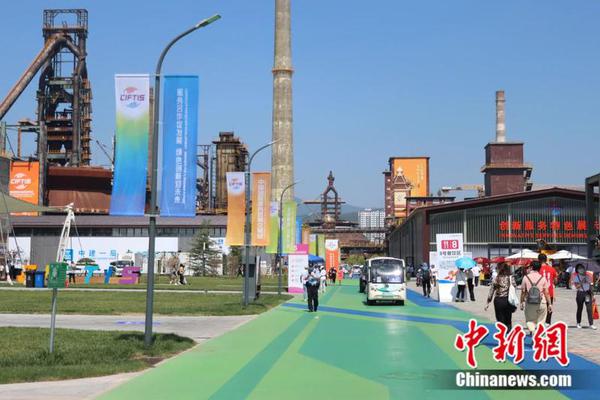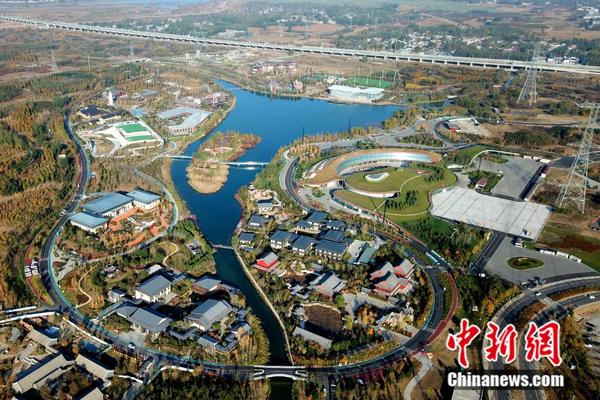An exclusive interview with Dr. Yin Jun, assistant dean of the Institute of Xi Jinping Thought on Socialism with Chinese Characteristics for a New Era, Peking University
The report of the 20th National Congress of the Communist Party of China has formally proposed "Chinese Path to Modernization". What is the fundamental feature of the Chinese Path to Modernization? What are the differences between Chinese and Western modernization theories? What are the theoretical innovation possibilities of the Chinese Path to Modernization? China News Service "W.E. Talk" recently has interviewed Dr. Yin Jun from Peking University, who is the assistant dean of the Institute of Xi Jinping Thought on Socialism with Chinese Characteristics for a New Era.
Here is an excerpt of the dialogue:
China News Service: Nobel Economics Prize winner Friedman has ever claimed: whoever can explain China's economy will win the Nobel Prize in Economics. What is the complexity of the Chinese economy according to your research?
Yin Jun: Over the past 70 years since the founding of the People's Republic of China, China has created an economic miracle that has "amazed the world". How to explain the " Riddle of Sphinx" of China's economic development is one of the hottest topics in the field of economics. The complexity of China's economy stems not only from the special national conditions such as the large population and considerable regional differences, but also from the fact that over the past 70 years, the whole process of China’s economic development cannot be simply summarized by the traditional development economics theory of "development transformation", but is remarkably manifested as the superposition of two types of transformation.
Firstly, China has undergone two transformations of its economic system. The first was the transition to a planned economic system through socialist transformation based on a new democratic society, and the second was the transition to a market economy after reform and opening up. Secondly, China has experienced two economic development transitions, namely, from "heavy industry priority development", to "high-speed economic growth", and then to "high-quality economic development". In this sense, China's economic development path is embodied as a dual-transition road of "development transition" and "system transition", which can also be summarized as "transition development", that is, "development in transition, transition in development", which in turn has brought tremendous complexity and sophistication to China’s economy.

The 2022 China International Fair for Trade in Services was held in Beijing. (Photo: China News Service/Niu Yungan)
China News Service: How to understand the fundamental characteristics of the Chinese Path to Modernization?
Yin Jun: The fundamental feature of the Chinese path to modernization lies in the leadership of the Communist Party of China (CPC), which is also the greatest advantage of the Chinese path to modernization. After the Opium War in 1840, China was forced to open its doors as a consequence of the invasion of Western powers, which, as is known, brought great humiliation to the country, heavy hardship to the people and vast disgrace to its civilization. During this time, some pioneers had already begun to explore or promote China's modernization.
It was not until the leadership of the CPC that China achieved the great victory of the New Democratic Revolution, completely ending the history of a semi-colonial and semi-feudal society and creating the fundamental social conditions for the Chinese Path to Modernization. In the process of the Chinese Path to Modernization, the CPC has firmly held the dominance of modernization in the hands of Chinese people, blazing a path of modernization according to the will of Chinese people.
Chinese path to modernization, with brief four words, is, however, very rich in its connotation, which means not only the goal of modernization but also the path of modernization is Chinese style. Therefore, the Chinese Path to Modernization is a meaningful combination of means and ends.
What is the goal of the Chinese Path to Modernization? In addition to the general goals of "wealth of the people" and "strength of the country" committed to by most countries in the world, due to the nature of the CPC and the requirements of its original mission, the Chinese Path to Modernization emphasizes people’s free and well-rounded development, taking coordinated development of both material and spirit of the people, happy life of the people, and the well-being of the people the overarching goal to pursue. The goal of the Chinese Path to Modernization is not "one-dimensional", but multi-dimensional.
What is the particular Chinese Path to Modernization? Drawing the grand blueprint for modernization while keeping abreast of the time, determining the central tasks and strategic goals at different stages, and consistently making efforts to strive for them is the scientific method of the CPC to build a modern country, and it is also the distinctive feature and unique advantage in the long-term governance of a Marxist political party. Take an analogy for example, the methods used by political parties in Western countries to promote modernization are similar to "challenge games", which is usually "different parties come and go", while the Chinese modernization method is similar to a "relay race" in the overall sense, "reaching a thousand miles by accumulating every single short step".

Citizens jog along the Jinji Lake in Suzhou, Jiangsu Province. (Photo: China News Service/Wang Jianzhong)
China News Service: Taking all the efforts of modernization explorations of countries around the world into consideration, what is especially well worth learning for China?
Yin Jun: Modernization originated from the capitalist and industrial civilization of Western Europe. For hundreds of years, the law of success and failure of modernization in all countries can be summarized in one sentence in short: the failure of modernization may lie in the superstition of "one size fits all" model or standard. Successful modernization must depend on theoretical and practical innovation under the combination of "general" law and "special" national conditions.
Therefore, there is neither a one-size-fits-all modernization model nor a universal modernization standard in the world. The exploration in the "generality" of modernization of other countries is worth learning, but the exploration in the "particularity" of modernization never simply goes like “giving and taking” directly.
What is a "general" law? For example, the modernization of all countries must consistently liberate and develop productive forces, with industrialization and urbanization as the driving force, and human welfare as the ultimate goal. "Generality" in this regard is manifested in the comparability and difference between countries. For example, measuring the level of productivity development is nothing more than economic indicators such as total output value, national income (or per capita gross output value, per capita national income), the ratio of industrial and agricultural output value, the ratio of urban to rural population, and the absolute output (or per capita output) of certain industrial products, to distinguish whether economic modernization has been achieved.
But modernization also has its "particularities". For example, countries should adopt measures in light of the time and in consistent with local conditions, constructing production relations adapted to the development of their own productive forces and establishing superstructures in accordance with their national conditions. Unlike economic modernization, systems vary widely across countries and are difficult to compare like cardinal or ordinal numbers. In other words, there is no single standard for institutional modernization. Unfortunately, in history, people have often taken for granted the systems of countries already achieved economic modernization as the standard for system modernization. This view or prejudice is mainly influenced by the thought of developmentalism. In order to facilitate abstract research, the mainstream trend of developmentalism attempts to attribute all modernization problems to the distribution of pure material interests, such as turning political, economic and natural environment problems into issues of material interest distribution among government, market, society and other subjects. Problems brought about by modernization, such as wealth inequality, unemployment, environmental destruction, ethnic conflicts, arms race, and wars, etc., they think, however, can be covered up by the achievements of material development; or to say, as long as the material economy develops, these problems can be solved accordingly. However, the long history of world modernization has proved time and time again that countries that mechanically copy the modernization paths of other countries are doomed to fail.

An aerial photo of Xiong'an. (Photo: China News Service/Han Bing)
China News Service: There have been three theories on the essential characteristics of the Chinese Path to Modernization: the theory of "making up for the lessons", the theory of "convergence" and the theory of "innovation". Why do you agree with the "innovation theory" in your book?
Yin Jun: After the reform and opening up, there used to be an inaccurate view that China built socialism on the basis of backward productive forces, and had to turn around to "make up for the lessons of capitalism" and pass through the capitalistic "Caudine Forks". The mistake of this "making up for the lessons" theory is that the practice of China's modernization since 1840 has proved that it is impossible for China to take the road of capitalism. The flexible innovation system and mechanism in the primary stage of socialism are to promote the development of productive forces and lay the material foundation for advancing to the advanced stage.
Another wrong view is that the difference between socialism and capitalism will become less and less obvious in the future. The mistake of this "convergence theory" is that socialist countries insist on public ownership as the main body and the principle of distribution according to work, which is impossible under the capitalist system and is fundamentally opposed to bourgeois ownership and the principle of capitalist distribution. Although socialist countries and capitalist countries aim to increase productivity and even both adopt the market economic system, the essential characteristics of socialism and capitalism are still different. For example, socialism has its institutional advantage whereas it is difficult for capitalism to get rid of such problems as the gulf between the rich and the poor and the polarization of wealth.
There is no doubt Chinese Path to Modernization is a kind of "innovation theory". It is a long-term process for a developing country under the socialist system to realize modernization, a long-term process for a great ancient civilization to achieve modernization, and a long-term process for a country with large population to reach modernization. This process includes not only continuous development of productivity, but also continuous improvement of the system. It is a great practice that has never been seen before. This most ambitious and unique practical innovation in human history will definitely provide a stronger driving force and expand broader space for theoretical creation and academic prosperity, and will for sure bring about great development of philosophy and social science in both China and the world. It is such an extraordinary time and era that each and every one of us should live up to.
Expert Introduction:
Dr. Yin Jun is the assistant dean and research fellow of the Institute of Xi Jinping Thought on Socialism with Chinese Characteristics for a New Era, Peking university. His main research fields include the Chinese path to Modernization, Five-Year Plan, Xi Jinping's economic thought, organization and management in the digital age, etc. Yin has written a number of books, such as China’s Plan for Economic and Social Development, The low-carbon Economy in China, China's New Urbanization Road, and The Nature of Leadership. His research has been published in journals such as Asia Pacific Journal of Management, Journal of Business Research, Journal of Innovation & Knowledge, etc. His latest book, Economic Theory and Chinese Path to Modernization: Rereading Li Yining, exploratorily refines the theoretical system of economics with Chinese characteristics and the analytical framework of the Chinese Path to Modernization.

Dr. Yin Jun (Provided by Yin Jun to chinanews.com)
Written by: By Li Shuangnan
Source: ECNS



